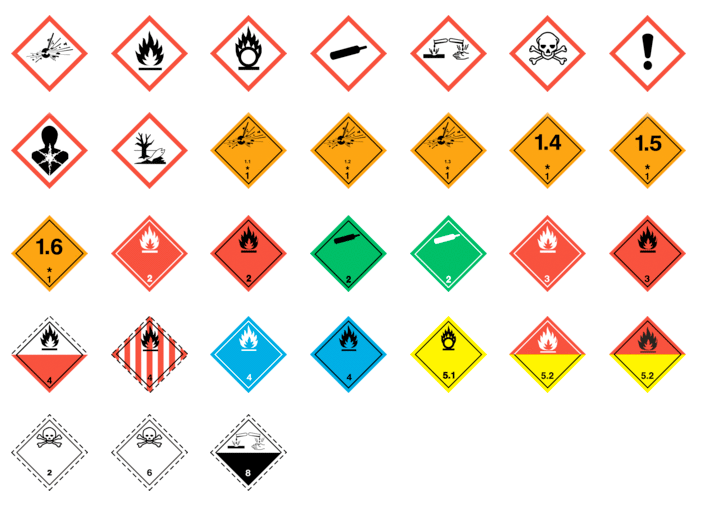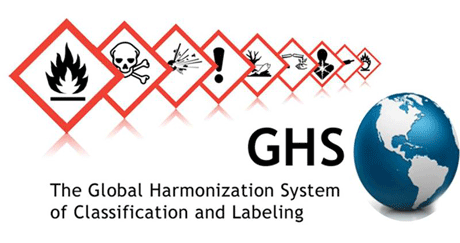|  The
Global Harmonized System (GHS) is maturing slowly but steadily
and impacting the ways of international trade and commerce. The
Global Harmonized System (GHS) is maturing slowly but steadily
and impacting the ways of international trade and commerce.
First things first: While GHS
is supposed to be a global application—harmonized in
its reach between the nation states’ varying legislations—and
provide an unique and systematic approach for manufacturers,
transporters, distributors, retailers, sellers, buyers, and
users of chemicals, there are still a number of issues.
GHS is, in short, a spin-off
of the UN Model Regulations, which in their current 19th edition
forms the basis for the worldwide modal transport regulations,
such as the IMDG code applicable to the transport of Dangerous
Goods by sea or the ICAO Technical Instructions applicable
to the transport of Dangerous Goods by Air.
In the U.S., 49 CFR covering
the transport of dangerous goods (or hazardous materials,
as these are dubbed in the U.S.) and, to a degree, 40 CFR
dealing with environmental matters have been harmonized with
the UN Model Regulations and GHS so as to do away with trade
barriers.
The aim of GHS was to replace
the differing classification and hazard communication or labeling
standards applied by different countries by means of using
consistent criteria for classification and hazard communication
on a global level.
The development of GHS kicked
off during the UN Conference in Rio, driven by stakeholders
such as the OECD (Organization for Economic Co-operation and
Development) and the ILO (International Labor Organization).
While certainly a main goal
was to harmonize the hazard communication standards for chemicals
on the user level, a second goal was to iron out differences
between hazard communication requirements applicable to the
transport of such chemicals and their use.
For the U.S., the final rule
mandating full GHS implementation into OSHA Standards was
published on March 26, 2012. Full adoption of GHS standards
by June 1st, 2015, is required for manufacturers and distributors
of chemical products. Workers had to be trained before December
1st, 2013.
For the European Community,
the regulations covering GHS implementation were published
on December 31st, 2008, and mandatory compliance for substance
classification in accordance with GHS requirements was December
1st, 2010; although a grace period was provided for the classification
of mixtures and solutions, which expires on June 1st, 2015.
 |
Something important to understand
is that GHS deals with the hazards arising from a substance’s
use, which is fundamentally different from hazards encountered
in transportation. While most of the world differentiates
between Transport regulations covering Dangerous Goods and
OSHA regulations covering hazardous substances, in the U.S.
this differentiation is made using the term hazardous materials
and hazardous substances.
Many issues pertaining to hazard
communication by means of SDS (Safety Data Sheets) stem from
misunderstandings of these terms; with very few exceptions,
a substance meeting the classification criteria for a Dangerous
Good will also be a hazardous substance, but one may not conclude
that a product covered by hazardous substance labeling requirements
is also a Dangerous Good.
While both the U.S. and the
EC adoption of the GHS saw distinct changes in the system
of chemical’s classification, which posed considerable
challenges for all stakeholders in the supply chain, currently
67 states have adopted the GHS system and more are to follow.
The alignment of the GHS hazard
communication standards with symbols used in transport for
decades should, at least in theory, boost understanding of
the particular hazards exhibited by a product and its use.
However, the differing hazards encountered during transportation
and during use of such products sometimes, in practice, result
in a non-consistent approach:
With GHS being a full-fledged
international standard, modal regulations now call for observance
of GHS labels to aid identification of potentially undeclared
or misdeclared shipments of Dangerous Goods, particularly
in air transport; but while certain household products may
not be exactly healthy, unfit for ingestion, and thus bearing
the skull-and-crossbones pictogram symbol, the classification
criteria applied in transport have not necessarily been met.
 Something of particular interest
for the U.S. market is the transition from the “MSDS”
or “Material Safety Data Sheet” to the uniform
“SDS” or “Safety Data Sheet” by means
of the HCS 2012, covered by 29 CFR 1910.1200 and organized
in 16 sections. One main benefit here is that this transition
should do away with the considerable differences between the
former US-MSDS and EC-SDS, easing the regulatory burden for
manufacturers of chemicals who offer their products in multiple
international markets. For the time being, however, compliance
providers such as market-leader Labelmaster are doing good
business with conversions from the old US-MSDS format to the
GHS-SDS format.
Something of particular interest
for the U.S. market is the transition from the “MSDS”
or “Material Safety Data Sheet” to the uniform
“SDS” or “Safety Data Sheet” by means
of the HCS 2012, covered by 29 CFR 1910.1200 and organized
in 16 sections. One main benefit here is that this transition
should do away with the considerable differences between the
former US-MSDS and EC-SDS, easing the regulatory burden for
manufacturers of chemicals who offer their products in multiple
international markets. For the time being, however, compliance
providers such as market-leader Labelmaster are doing good
business with conversions from the old US-MSDS format to the
GHS-SDS format.
One issue not directly related
to GHS always has been and still is the simple fact that a
considerable percentage of people using SDS have never been
properly trained in how to read and understand such a document.
An SDS will usually list the ingredients of a product and
identify the hazards for any given ingredient—thus,
a flashpoint and boiling point in a range indicating a “flammable
liquid” in transport (in other words, making this liquid
a Dangerous Good when transported) refers to the flammability
of the ingredient and not the end-product as such. Also, articles
do not require SDS of any kind (batteries, fuel pumps, and
other dangerous goods commonly incorporated into machinery
or apparatus come to mind). While an air-conditioning unit
might be accompanied by an SDS identifying, for example, a
“UN 1028, Refrigerant gas R12” this classification
actually pertains to the refrigerant gas contained in the
air conditioning unit. The unit as such—the “article”,
in transport-speak—would be identified as “UN
2857, Refrigerating machines” (although it would likely
be exempt from the transport-related requirements under applicable
modal Dangerous Goods Regulations when containing not more
than 12 kg [26.5 lbs.] of a non-flammable, non-toxic refrigerant
gas).
In practice such issues are
indeed causing delays, unplanned expenses, and fruitless discussions,
since not all articles written in abundance about GHS and
its correct application were suitable to be understood by
a broader audience, which does include the stakeholders.
A common misperception is that
“anyone repacking or redistributing a chemical in commerce
may simply transfer the (GHS and or DG transport) label and
SDS information” as long as the substance is not diluted,
mixed, or otherwise altered. While that is usually the case,
notable exceptions do exist—and sometimes even the competent
authorities of different states have differing opinions, not
to the benefit of the manufacturer or distributor.
And while GHS is a global undertaking,
nothing in the UN’s GHS Handbook prevents nation states
from imposing additional requirements above and beyond GHS
in regard to OSHA hazard communication requirements. So while
GHS is a huge step ahead and a most welcome lowering of trade
barriers, certain small differences stemming from national
legislation may be less obvious than before, but all the more
important.
As for trade between Europe
and North America, the trade agreements TTIP (Transatlantic
Trade and Investment Partnership – EC/US) and CETA (Comprehensive
Trade and Economic Agreement – EC-Canada) should further
facilitate the uniform application of such standards and do
away with most particular requirements of the nation states,
as these would—under these agreements—be considered
the trade barriers, which they are, as a matter of fact.
While the overall quality of
SDS should improve with full GHS implementation and while
it should ease the ordeal of comparing products in different
markets, it must still be said that using SDS as the sole
source of assessing health risks associated with the use of
such products by employees or buyers in commerce or using
the SDS as a means of transport classification may still not
be a good idea. Something the
old MSDS and the new SDS have in common is that just one part
is guaranteed to be legally binding: the disclaimer at the
end stipulating that “all information is based on current
knowledge and is intended to describe the product for the
purposes of health, safety, and environmental requirements
only. It should not therefore be construed as guaranteeing
any specific property of the product. Information in this
SDS is from available published sources and is believed to
be accurate. No warranty, express or implied, is made and
no liability is assumed resulting from the use of this SDS.
The user must determine suitability of this information for
his application.”
Jens
|









 The
Global Harmonized System (GHS) is maturing slowly but steadily
and impacting the ways of international trade and commerce.
The
Global Harmonized System (GHS) is maturing slowly but steadily
and impacting the ways of international trade and commerce.

 Something of particular interest
for the U.S. market is the transition from the “MSDS”
or “Material Safety Data Sheet” to the uniform
“SDS” or “Safety Data Sheet” by means
of the HCS 2012, covered by 29 CFR 1910.1200 and organized
in 16 sections. One main benefit here is that this transition
should do away with the considerable differences between the
former US-MSDS and EC-SDS, easing the regulatory burden for
manufacturers of chemicals who offer their products in multiple
international markets. For the time being, however, compliance
providers such as market-leader Labelmaster are doing good
business with conversions from the old US-MSDS format to the
GHS-SDS format.
Something of particular interest
for the U.S. market is the transition from the “MSDS”
or “Material Safety Data Sheet” to the uniform
“SDS” or “Safety Data Sheet” by means
of the HCS 2012, covered by 29 CFR 1910.1200 and organized
in 16 sections. One main benefit here is that this transition
should do away with the considerable differences between the
former US-MSDS and EC-SDS, easing the regulatory burden for
manufacturers of chemicals who offer their products in multiple
international markets. For the time being, however, compliance
providers such as market-leader Labelmaster are doing good
business with conversions from the old US-MSDS format to the
GHS-SDS format.

 Vital
Views 1975-2015
Vital
Views 1975-2015 
 He
pointed to the integrators as “lighting
the way and the combination airlines will need
to begin the process of redirecting their cargo
operations from passenger hubs in order to compete
in the new customer-directed transportation environment.
The future of global air cargo is all about running
the distribution networks to meet the increasingly
time-definite, door-to-door needs of the customer.
Ultimately, cargo-dedicated airports are key partners
and a vital component in achieving the logistical
goals of the customer.”
He
pointed to the integrators as “lighting
the way and the combination airlines will need
to begin the process of redirecting their cargo
operations from passenger hubs in order to compete
in the new customer-directed transportation environment.
The future of global air cargo is all about running
the distribution networks to meet the increasingly
time-definite, door-to-door needs of the customer.
Ultimately, cargo-dedicated airports are key partners
and a vital component in achieving the logistical
goals of the customer.”

